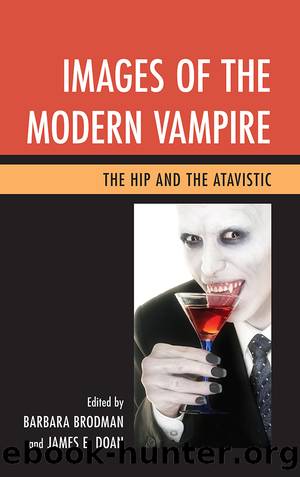Images of the Modern Vampire: The Hip and the Atavistic by Barbara Brodman & James E. Doan

Author:Barbara Brodman & James E. Doan [Brodman, Barbara & Doan, James E.]
Language: eng
Format: epub
Publisher: Fairleigh Dickinson University Press
Published: 2013-08-14T16:00:00+00:00
III
New Readings of the Vampire
10
Blood-Abstinent Vampires and the Women Who Consume Them
Alaina Christensen
âWe call ourselves vegetarians,â Edward Cullen tells Bella Swan, with no small dose of irony.1 The Cullen family of vampires chooses not to consume human blood, and instead to live off the blood of woodland animals; it is because of this abstinence that Edward is able to enter into a relationship with Bella in The Twilight Saga, Stephenie Meyerâs best-selling series. However, just because Edward doesnât intend to take some surreptitious sips from the lovely Bella does not mean that no one is devoured in The Twilight Saga. Ironically enough, it is the Cullens, and the latest incarnation of the popular culture vampire, who are consumed. The Cullens are portrayed not only as desirable consumables within the novels but also for hoards of fans the world over. Texts like The Twilight Saga, which will be the primary discussion in this chapter, but also True Blood, The Vampire Diaries, and their predecessors, Buffy the Vampire Slayer and Angel are ushering in a new era for the vampire archetype: the vampire as a sexy consumer object. Applying the theories of Jean Baudrillard,2 particularly his theories on sign value in a consumer society, we find contemporary vampire texts ripe with new and surprising examples of consumption. Baudrillard argues that sign value, or the signification of âworthâ and desirability, drives our late-capitalist consumer economy; the term âconsumptionâ then deals with not only economic purchasing, but also metaphorical consumption, including how members of Westernized society participate in society, in culture, and in other signification systems.
No longer scary monsters in the dark, vampires are now tortured heroes and boyfriends for a few lucky heroines like the women of recent vampire fictions. The vampires of recent pop-culture texts all feature similar male vampires as anti-heroes who are sensitive and have the emotional complexity typically reserved for humans. These new romantic human-vampire relationships have led to vampires as general characters coming out of the shadows (so to speak) to interact with human characters in ways far beyond predator and prey. Vampires have always been fascinating creatures in science fiction and fantasy genres: dangerous and with a variety of supernatural powers, these once-human-but-no-longer-living characters are isolated from, yet unable to live without, humans. If one looks at the typical vampire body, it is not difficult to discern why these creatures exemplify the desirable Otherâs3 body. Whether beautiful or not, and strong ranging towards invincible, vampires retain enough humanity or human traits to be comparable to humans but never seem to suffer the many faults of human bodies. And by investing (whether time, money, or attention) in the prolific number of texts abounding today, audiencesâin a process of âsymbolic exchangeââare able to appropriate vampiresâ desirable attributes for themselves as they consume the text. In this way, these new vampires are not only designed to kill, they are designed to be desired or to be consumed by their own prey.
Baudrillard argues that Western society exists in a system of
Download
This site does not store any files on its server. We only index and link to content provided by other sites. Please contact the content providers to delete copyright contents if any and email us, we'll remove relevant links or contents immediately.
Wonder by R.J. Palacio(8430)
Mastering Adobe Animate 2023 - Third Edition by Joseph Labrecque(3720)
Unlabel: Selling You Without Selling Out by Marc Ecko(3574)
Ogilvy on Advertising by David Ogilvy(3485)
Hidden Persuasion: 33 psychological influence techniques in advertising by Marc Andrews & Matthijs van Leeuwen & Rick van Baaren(3454)
Drawing Cutting Edge Anatomy by Christopher Hart(3440)
The Pixar Touch by David A. Price(3347)
POP by Steven Heller(3297)
The Code Book by Simon Singh(3057)
The Art of War Visualized by Jessica Hagy(2932)
Slugfest by Reed Tucker(2924)
The Curated Closet by Anuschka Rees(2897)
Rapid Viz: A New Method for the Rapid Visualization of Ideas by Kurt Hanks & Larry Belliston(2815)
Stacked Decks by The Rotenberg Collection(2796)
365 Days of Wonder by R.J. Palacio(2737)
The Wardrobe Wakeup by Lois Joy Johnson(2717)
Keep Going by Austin Kleon(2682)
Tattoo Art by Doralba Picerno(2583)
Tell Me More by Kelly Corrigan(2579)
